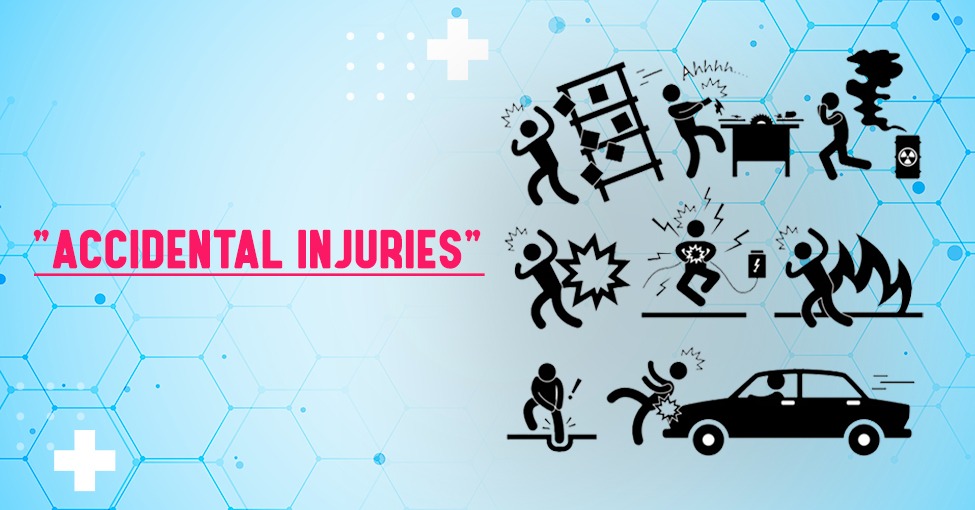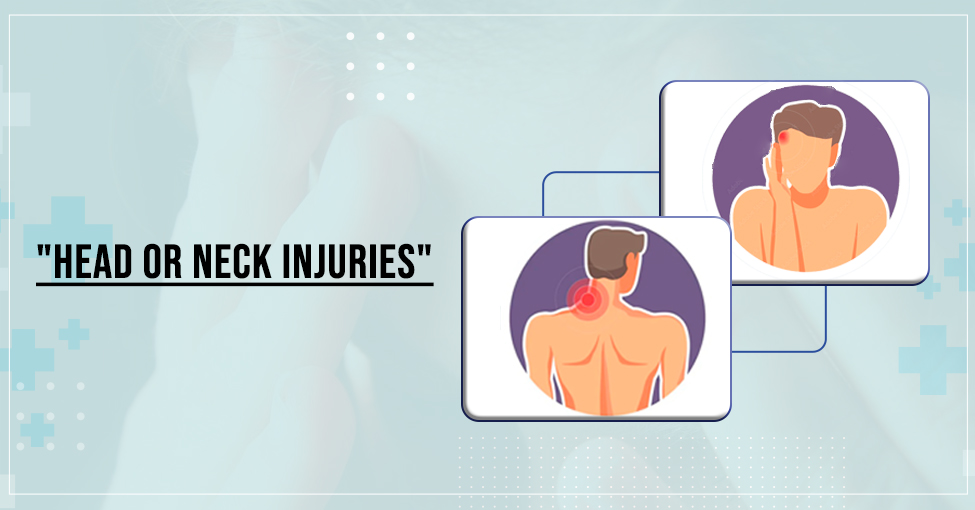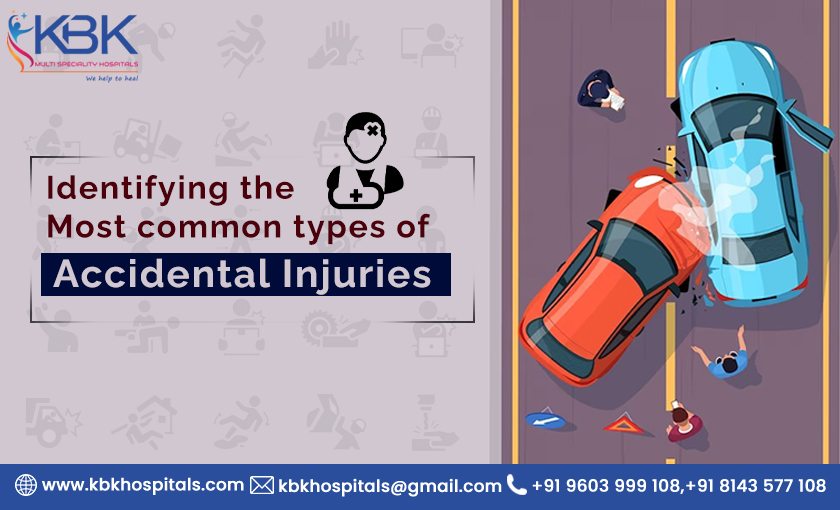Introduction:
Accidental injuries can happen to anyone at any time and place. These are one of the most common reasons for hospital emergency room visits. These unfortunate incidents occur frequently and can devastate adults and children. These injuries can range from minor bruises and cuts to more severe injuries such as broken bones, concussions, and burns. It is essential to identify the most common types of accidental injuries and how to treat them to prevent further harm. If the injury case is severe, one might need medical attention. Here we will discuss the most common types of accidental injuries and how to treat them.
What is an injury?
Injury is the general term for physical damage resulting from an event, such as an accident or a sporting activity. Accidental injury can occur due to car accidents, slips or falls, medical malpractice, and even drinking too much. No matter the cause, injuries can be painful and debilitating, resulting in medical bills, lost time at work, and long-term effects such as chronic pain or disabilities. Understanding what constitutes an injury can provide you with the knowledge and resources necessary to help prevent it from occurring in the future.
Injuries can be a cruel twist of fate, leaving us helpless and uncertain. But having someone to turn to in such an unexpected moment gives us the hope we need for recovery. So if you face injury, don’t hesitate to reach out and get the support you deserve!
What are accidental injuries?

Accidental injuries are not planned. It causes physical injuries unexpectedly. Accidents, trauma, falls, cuts, and burns are some examples of accident injuries. These injuries can occur anywhere, at any time, and to anyone, irrespective of age, gender, or race. Sometimes accidental injuries can severely impact the individual and or their family. It causes pain, suffering, disability, and sometimes even death.
Various factors, such as environmental factors, human error, lack of safety measures, or negligence, can cause accidental injuries.
Accidents are common, and the reality is that injuries often result. To keep your environment safe, you must learn about different incidents to know how best to respond if they happen – with no wasted time!
Here are some examples of serious issues encountered in various places and advice on steps to take after an incident.
Head or neck injury:

Head or neck injuries can be caused by falls, accidents, or blows to the head. In some cases, these injuries can cause severe pain with permanent injuries. These types of injuries need some additional care.
The symptoms of a head injury can vary from mild to severe, including headache, dizziness, confusion, and loss of consciousness.
You need to follow some simple steps to make it less harmful. The first step in treating a head injury is to calm the affected person and lie down. Apply ice to reduce swelling. If the person loses consciousness or vomits, seek medical attention immediately.
The patient’s body might be in an awkward position. So it will be better to avoid moving the patient.
Spinal cord injuries:
Accidental spinal cord injuries are among some of the most severe and life-changing injuries that can occur. The spinal cord is an intricate system that plays a vital role in the body’s communication and mobility. This long, thin column of nerves runs from the base of your skull to your tailbone. It affects portions of the body below the injury site. Spinal cord injury can result from many accidents, including collisions, falls, and other traumas. Accidents resulting in a spinal cord injury can cause serious health challenges due to paralysis or weakness. In addition to physical disabilities, these injuries often cause psychological consequences that drastically alter one’s quality of life.
The critical issue is when a person gets a spinal cord injury, the brain can’t get the right message from the whole body. It can lead to full or partial paralysis. Sometimes a patient may require to rely on wheelchairs for movement.
Slip and fall:
Slips and falls are nothing to joke about, especially for those over 65. They can occur anywhere, such as at home, in the workplace, on the street, or in public places. Thankfully, there is an easy way to avoid these tragedies altogether. Removing clutter could create hazardous conditions in our homes or environments. For this reason, you can protect yourself and others from any potential danger posed by unexpected slips and tumbles.
Motor vehicle accidents:
Accidental injury due to motor vehicle accidents has become an increasingly concerning issue in recent years. This is one of the leading causes of death for both children and adults. Distracted, impaired, and reckless driving are life-threatening behaviors that can quickly lead to road tragedy. Phone use is one of the most common distractions responsible for car accidents yearly. However, drinking while under the influence or speeding can be just as deadly. According to a report by The National Highway Traffic Safety Administration, more than 10 thousand people lost their lives in crashes due solely to alcohol impairment last year – an important reminder of why we remain alert when behind the wheel and prioritize our safety above all else.
Multiple types of first aid as per the accident –
For every severe accident, the first step is to go to a hospital. Before they arrive, you can take first aid, which must be valuable.
Below are some helpful first-aid tips you can use while waiting for the emergency medical service.
For bleeding first aid:
If a person is bleeding, the first step is to stop the bleeding quickly and then protect the injured wound.
- For that, you need to cover the wound with clean cotton.
- Then apply pressure to stop bleeding.
- You can apply more bandages over the dressing area. That will create pressure and help stop bleeding.
First aid for burns:
Burn treatments are different based on their types. So before treating the burns, try to know about the source. This will help you to treat the patient when you know the actual cause.
- You can remove the source of the burn.
- Put it below cold running water to prevent pain.
- Make sure to cover the burning area loosely to stop infection.
- Use some antibiotic cream if the burn area is small with first-degree burns.
For choking first aid:
The brain and lungs cannot receive enough oxygen when someone is choking. More than 4 minutes without oxygen to the brain might result in death or permanent brain damage. Everyone has to be able to spot choking signs and know what to do as first aid to solve this.
- Make sure to put the patient in a standing position.
- You can put your arm around their waist and make five fast thrusts with the thumb side of your fist just over their navel.
Final word –
Accidental injuries can be treated in various ways, and their recommended treatments depend on the type of injury. In some cases, natural remedies effectively provide better results, but these are temporary. Those who need medical treatment can go to KBK Multispecialty hospital. It provides top care with various specialists. Anytime there you can emergency help. As prevention is always better than cure, we have also provided details on minimizing the risk of accidental injuries in the earlier sections. But everyone should follow safety protocols to reduce the chances of accidents.
FAQ’s:
1. What are accidental injuries?
Accidental injury is commonly known as a physical body injury caused by any external force, fall, or vehicle accident. Some accident injuries can result in long-term disabilities or even death. Sometimes it is minor that through first aid, you can cure it. In some cases, it has become severe that you need to go for medical treatment.
2. What are the types of accidental injuries?
Accidental injuries are always an unfortunate reality of life. Some examples of accidental injuries are falling, burns, road or vehicle accidents, bites, sports injuries, etc. Sometimes it becomes severe and takes a long time to recover with proper medical attention. Some primary self-care can help you to avoid this accidental injury. But it is necessary to take safety precautions to protect yourself against accidental injuries whenever possible.
3. Where are fatal injuries most commonly encountered?
Unfortunately, accidental injuries are far too common and lead to thousands of preventable fatalities each year. According to World Health Organization (WHO) data, the most common locations for accidental deaths are in the home or workplace. Over 60% of accidental injury-related fatalities occur in these two environments annually. It is essential always to be aware of potential hazards in both everyday locations to avoid fatal situations as much as possible. Accidental death can be reduced by taking necessary safety precautions and being mindful of hazardous conditions.
4. What is considered a work-related injury?
A work-related injury is any accidental injury in the workplace due to employee negligence or hazardous conditions. This could be anything from damaged property to an individual being physically hurt onsite to any collision or fire caused by the carelessness of employees. Such issues often happen in the office and can result in medical bills for the victims, lost wages, or demotion from the company. It’s essential to take safety precautions seriously, and employers should ensure their premises are not put at risk for accidental injury due to inefficient processes.
5. What are the most common injuries at work?
Workplace injury is an unfortunate reality of modern-day labor. Every year, hundreds of thousands of accidental injuries occur in the working world, resulting in costly medical bills and time off work. Slips fall, mental injuries, trips, and lifting objects are common workplace injuries. Sometimes it can cause broken bones, back injuries, or muscle strain.

